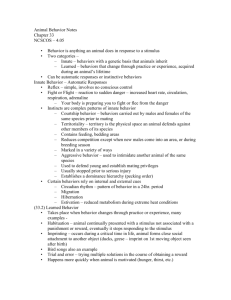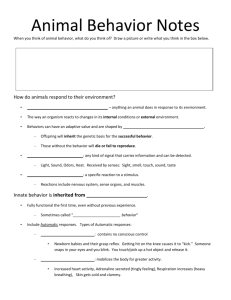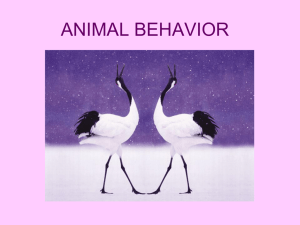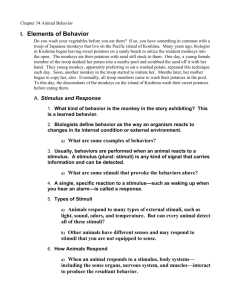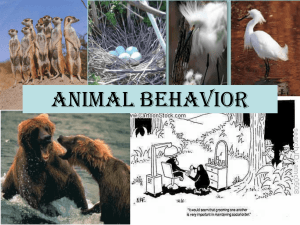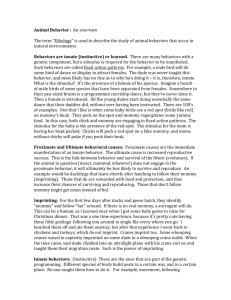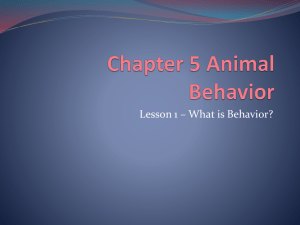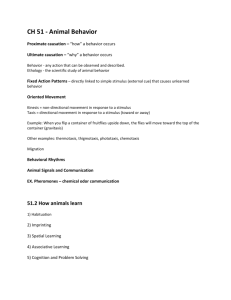Lecture 050 - Animal Behavior
advertisement
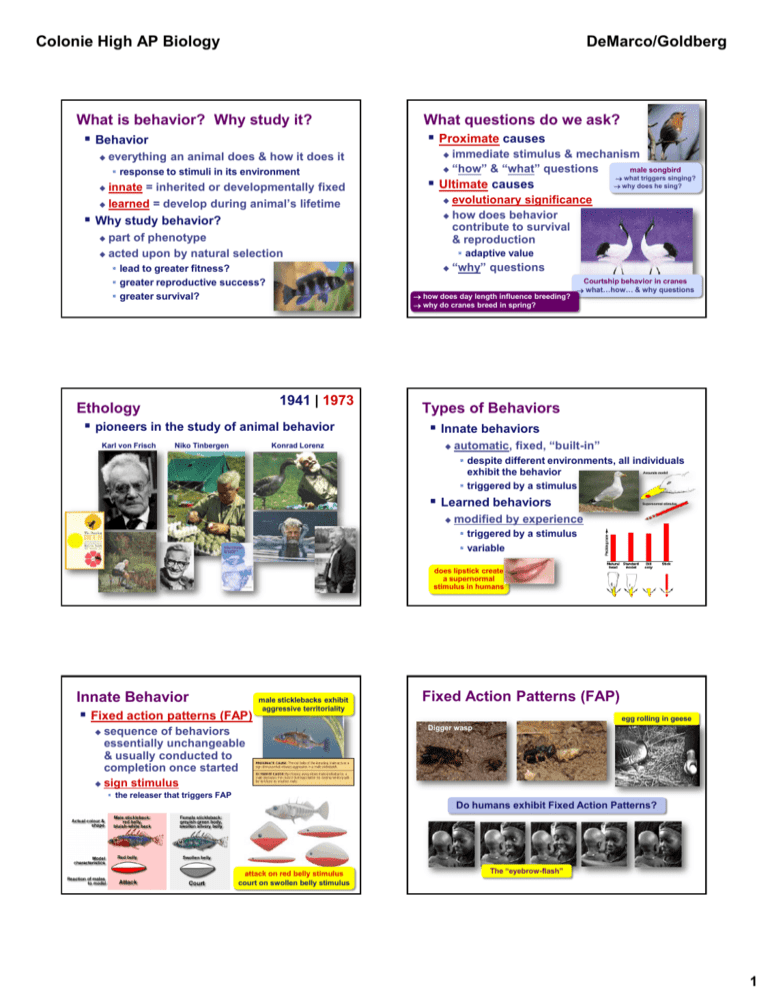
Colonie High AP Biology DeMarco/Goldberg What is behavior? Why study it? Behavior everything an animal does & how it does it response to stimuli in its environment innate = inherited or developmentally fixed learned = develop during animal’s lifetime Why study behavior? What questions do we ask? Proximate causes part of phenotype acted upon by natural selection evolutionary significance how does behavior contribute to survival & reproduction adaptive value “why” questions greater reproductive success? greater survival? how does day length influence breeding? why do cranes breed in spring? 1941 | 1973 Ethology pioneers in the study of animal behavior Karl von Frisch Niko Tinbergen Konrad Lorenz what triggers singing? why does he sing? Ultimate causes lead to greater fitness? immediate stimulus & mechanism male songbird “how” & “what” questions Courtship behavior in cranes what…how… & why questions Types of Behaviors Innate behaviors automatic, fixed, “built-in” despite different environments, all individuals exhibit the behavior triggered by a stimulus Learned behaviors modified by experience triggered by a stimulus variable does lipstick create a supernormal stimulus in humans Innate Behavior Fixed action patterns (FAP) male sticklebacks exhibit aggressive territoriality sequence of behaviors essentially unchangeable & usually conducted to completion once started sign stimulus Fixed Action Patterns (FAP) egg rolling in geese Digger wasp the releaser that triggers FAP Do humans exhibit Fixed Action Patterns? attack on red belly stimulus court on swollen belly stimulus The “eyebrow-flash” 1 Colonie High AP Biology DeMarco/Goldberg Circadian Rythyms Directed Movements Taxis daily cycles of behavior most are entrained to light dark cycles of animals environment change in direction automatic movement toward (positive taxis) or away from (negative taxis) a stimulus phototaxis chemotaxis Kinesis Migration Complex behavior, but still innate “migratory restlessness” seen in birds bred & raised in captivity navigate by sun, stars, Earth magnetic Sandpiper fields Monarch migration Bobolink Golden plover Imprinting Learning at a specific critical time forming social attachments both learning & innate components Konrad Lorenz Critical Period Sensitive phase for Conservation Conservation biologists have taken advantage of imprinting by young whooping cranes as a means to teach the birds a migration route. A pilot wearing a crane suit in an Ultralight plane acts as a surrogate parent. change in rate of movement in response to a stimulus optimal imprinting Wattled crane conservation teaching cranes to migrate As a brood parasite, the Cuckoo never learn the song of their species as a nestling. Song development is totally innate. imprinting in humans? 2 Colonie High AP Biology DeMarco/Goldberg Learned Behavior Associative learning Habituation Loss of response to stimulus learning to associate one feature of the environment (stimulus) with another operant conditioning trial & error learning associate behavior with reward or punishment “cry-wolf” effect learn not to respond to repeated occurrences of stimulus classical conditioning Pavlovian conditioning associate a “neutral stimulus” with a “significant stimulus” Social Behaviors Interactions between individuals develop as evolutionary adaptations language agonistic behaviors dominance hierarchy altruistic behavior Communication by Song Bird song Language Honey bee communication dance to communicate location of food source waggle dance Social Behaviors Agonistic behaviors species identification & mating ritual mixed learned & innate critical learning period Insect song threatening & submissive rituals symbolic, usually no harm done Red-winged blackbird mating ritual & song innate, genetically controlled 3 Colonie High AP Biology DeMarco/Goldberg Social Behaviors Dominance hierarchy Social Behaviors Altruistic behavior reduces individual fitness but increases fitness of recipient kin selection social ranking within a group pecking order Belding ground squirrel How can this be of adaptive value? Social Behaviors Cooperation Social Interaction & Communication Pheromones pack of African dogs hunting wildebeest cooperatively chemical signal that stimulates a response from other individuals alarm pheromones sex pheromones white pelicans “herding” school of fish Pheromones Territoriality Female mosquito use CO2 concentrations to locate victims marking territory The female lion lures male by spreading sex pheromones, but also by posture & movements Spider using moth sex pheromones, as allomones, to lure its prey. 4
